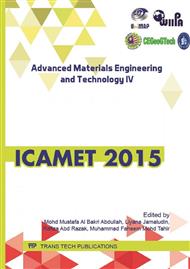p.93
p.101
p.106
p.111
p.116
p.121
p.126
p.131
p.136
Characterization of Silicon Carbide Nanowhiskers Synthesized by Microwave Heating Using Photoluminescence Spectroscopy and Fourier Transform Infrared Spectroscopy
Abstract:
Silicon carbide is an attractive material for engineering and industrial applications in harsh conditions. In manufacturing process, conventional heating process is commonly used to synthesis the silicon carbide. In this study, SiC nanowhiskers were synthesized from microwave heating of mixture of graphite and silica in the ratio of 3: 1. The mixture was heated by using laboratory microwaves oven to 1400°C at heating rate of 20 °C/min and temperature was hold for 30 minutes. Photoluminescence spectroscopy and Fourier transform infrared spectroscopy were used to characterize the SiC nanowhiskers. Photoluminescence spectrum of SiC nanowhiskers showed a sharp peak at 420 nm corresponding to band gap of SiC (2.39 ev). FTIR absorption spectra of SiCNWs recorded a band at 805.22 cm-1 corresponding to Si-C bond.
Info:
Periodical:
Pages:
116-120
Citation:
Online since:
May 2016
Keywords:
Price:
Сopyright:
© 2016 Trans Tech Publications Ltd. All Rights Reserved
Share:
Citation:


